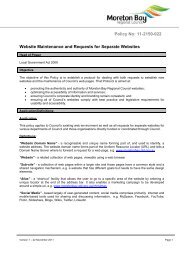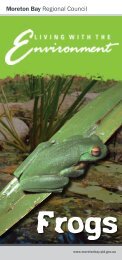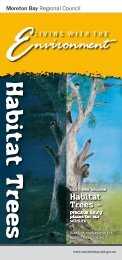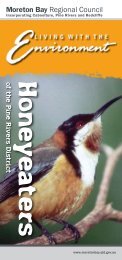South East Queensland Ecological Restoration Framework: Manual
South East Queensland Ecological Restoration Framework: Manual
South East Queensland Ecological Restoration Framework: Manual
You also want an ePaper? Increase the reach of your titles
YUMPU automatically turns print PDFs into web optimized ePapers that Google loves.
5.3.3.11 Stem-injection<br />
Large woody weeds such as camphor laurel, coral trees<br />
(Erythrina spp, Privet Ligustrum spp) and umbrella trees are<br />
generally treated by stem-injection. Holes are drilled at regular<br />
intervals around the base of the tree and exposed roots<br />
using a drill powered by either batteries or a generator. A<br />
tree injection syringe attached to a small capacity knapsack<br />
is used to fill the holes with the herbicide. Stem-injection of<br />
trees can also be undertaken using a hatchet to create cuts<br />
in a ‘brickwork pattern’ in trunks of trees for the application<br />
of herbicide (known as tree frilling). Frilling is more labourintensive<br />
than drilling, especially where trees are multistemmed<br />
or where there is limited room to swing a hatchet.<br />
Whichever method is used, the greatest benefit of steminjection<br />
is that the trees can be left standing in situ as they<br />
die, provided there is no risk to humans or infrastructure from<br />
falling limbs. This creates convenient roosts for birds and other<br />
animals, and prevents the formation of large amounts of debris<br />
on the ground and damage to understorey plants which<br />
would result if the trees were to be cut down using a chainsaw.<br />
Figure 9 – Stem-injection<br />
CASE STUDY 3<br />
THE SITE<br />
Hurst Family Park is a riparian zone 3.9km long with<br />
vegetation occurring on both sides of the creek and is<br />
approx. 17.2ha in size. Native vegetation is made up of<br />
five Regional Ecosystems including 12.3.1, endangered<br />
vine forest on alluvial plains; 12.3.7 (Eucalyptus tereticornis,<br />
Melaleuca viminalis and Casuarina cunninghamiana)<br />
along water courses and 12.3.11, which is listed as an ‘of<br />
concern’ tall woodland to tall open forest.<br />
RESTORING RIPARIAN VEGETATION<br />
IMPActed BY SEVERE CAT’S CLAW CREEPER<br />
- HURST FAMILY PARK, NERANG<br />
- Gold Coast City Council<br />
THE PROBLEM<br />
Cat’s claw creeper (Macfadyena unguis-cati) present<br />
at all layers of the forest with heavy vines starting to<br />
collapse mature river oak and vines severely impacting<br />
on many native plants in the mid and lower storeys. The<br />
thick carpets on the ground smothered populations<br />
of plants, altering habitat and preventing native plant<br />
regeneration. Numerous other weeds occurred at the<br />
site including madeira vine, Dutchman’s pipe, camphor<br />
laurel, devil’s fig, tobacco bush, Singapore daisy, trad<br />
and exotic grasses such as setaria. Cat’s claw posed the<br />
biggest threat of all the weeds present.<br />
Before<br />
Actions<br />
Some primary works had been done by the Nerang River<br />
Keepers, the local community group, but it was decided<br />
they move sites to ensure their viability as psychological<br />
advances in the initial years are difficult on such a weed<br />
infested site. The group however assisted the restoration<br />
process by controlling some of the more mature cat’s<br />
claw vines, freeing up the canopy and planting trees<br />
at the entrance of the park to assist with gaining more<br />
community support for the river.<br />
SEQ <strong>Restoration</strong> <strong>Framework</strong><br />
98<br />
MANUAL


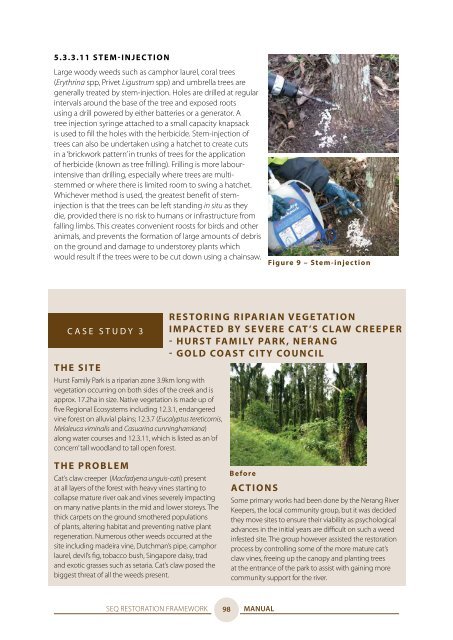
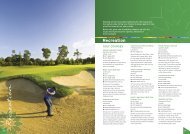

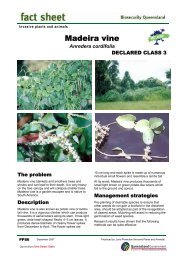
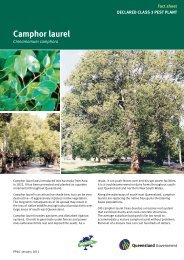


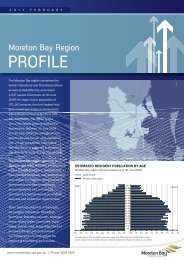
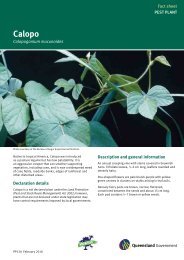

![Kumbartcho Brochure [PDF 540KB] - Moreton Bay Regional Council](https://img.yumpu.com/47220970/1/190x101/kumbartcho-brochure-pdf-540kb-moreton-bay-regional-council.jpg?quality=85)
